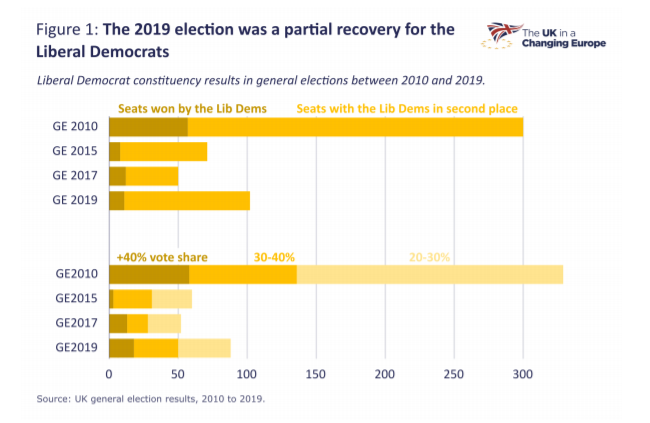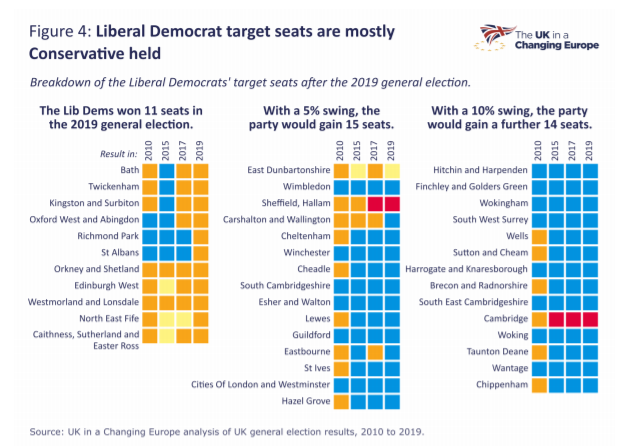Where next for the Liberal Democrats? New research report published
Think tank The UK in a Changing Europe has new research out today looking at the political prospects for the Liberal Democrats.
Key findings include:
More seats up for grabs

Although the 2019 general election was a huge disappointment, it contained the seeds of future recovery with a major increase in the number of seats the party is in contention in.
In 2010, there were nearly 140 seats where the party got over 30% of the vote. By 2017 that had fallen to 28. In December 2019, the party rebounded to 50 seats where it either won or is now within realistic touching distance.
Moreover, the 91 seats in which the party is now in second place is significantly higher than the 66 in which it finished second in 2015, and especially the 38 in which it was the runner up in 2017.
An emerging core vote
The initial signs of the creation of a new and larger core vote seen in previous years continued in the 2019 general election. The party’s support particularly grew in a ‘yellow halo’ of support in London and the South (especially the South East).
Linked to that, the party did particularly well in areas with higher proportions of graduates. The party either holds now or is highly competitive in 30% of the 64 seats that are in the ‘top ten’ in terms of the relative number of graduates in the UK.
There is an understandable temptation for some in the party to look at any variation in the party’s strengthen and respond by demanding the party prioritises its weakest areas. However, under first past the post, strength unevenly distributed and concentrated in particular areas delivers better results. Being equally spread everywhere is a recipe for failure, not success, unless you can leap up to 40%+ of the vote (where it then means you can sweep the board, SNP-style)/
The Conservatives are the main Westminster election opponents
 In 23 of the 29 seats that the Lib Dems are nominally best placed in to gain, the party holding the seat is the Conservatives. (This is based on a simple reading of electoral numbers. Which seats the party actually is best placed to win of course also depends on other factors such as the quality of the candidate. So take this list as an indication of the overall political picture rather than a sure guide to which seats the party will target.)
In 23 of the 29 seats that the Lib Dems are nominally best placed in to gain, the party holding the seat is the Conservatives. (This is based on a simple reading of electoral numbers. Which seats the party actually is best placed to win of course also depends on other factors such as the quality of the candidate. So take this list as an indication of the overall political picture rather than a sure guide to which seats the party will target.)
Moreover, there is little direct competition at general election level between Labour and the Liberal Democrats. There are only nine seats where the two parties together took either first or second place in 2019, whereas in 2010, there were 95.
Find out more
I’ll be discussing the report in more detail with Professor Tim Bale next week on my podcast, Never Mind The Bar Charts. Subscribe now in your podcast app to make sure you don’t miss out. [UPDATE: Here is the podcast.]
In the meantime, you can read the report in full here.
Listen to the Liberal Democrats and British politics being discussed by myself and a wide range of experts from inside and outside the party on my podcast, Never Mind The Bar Charts.